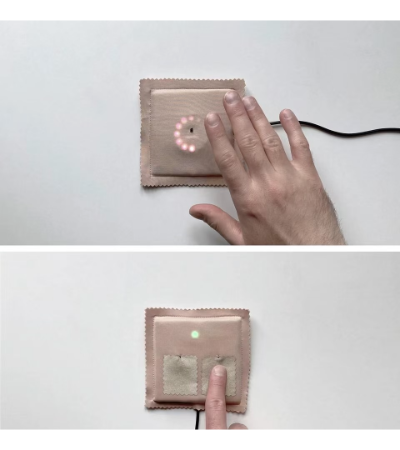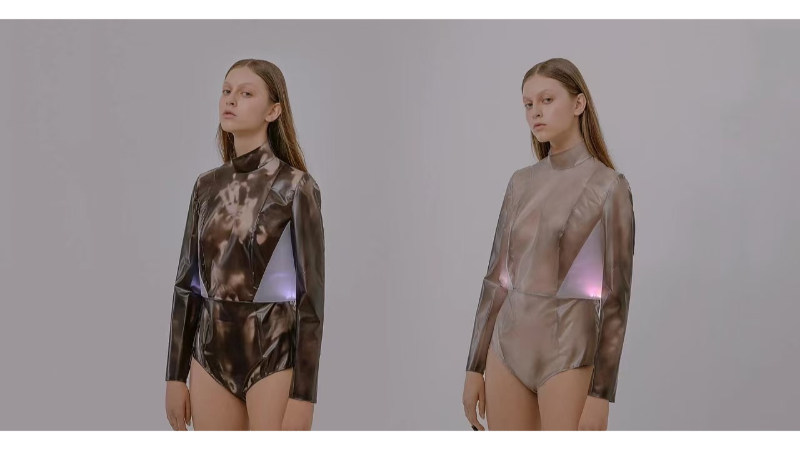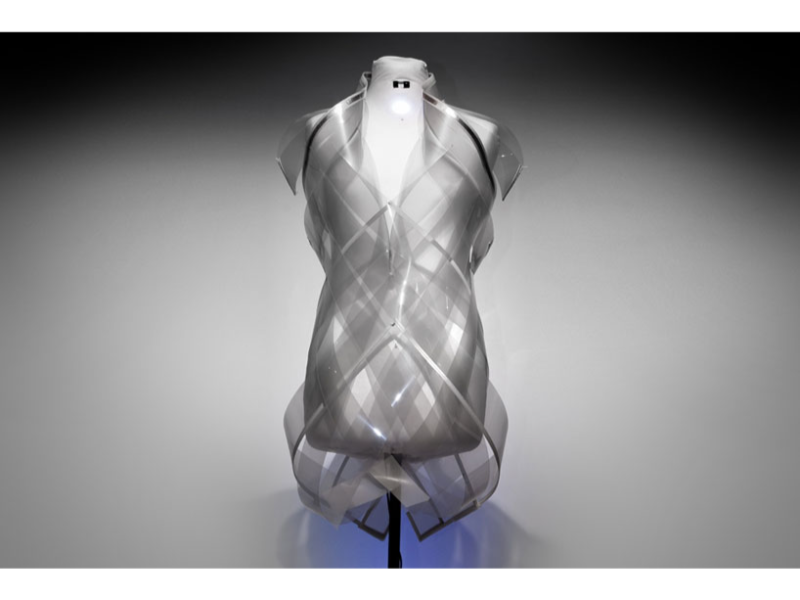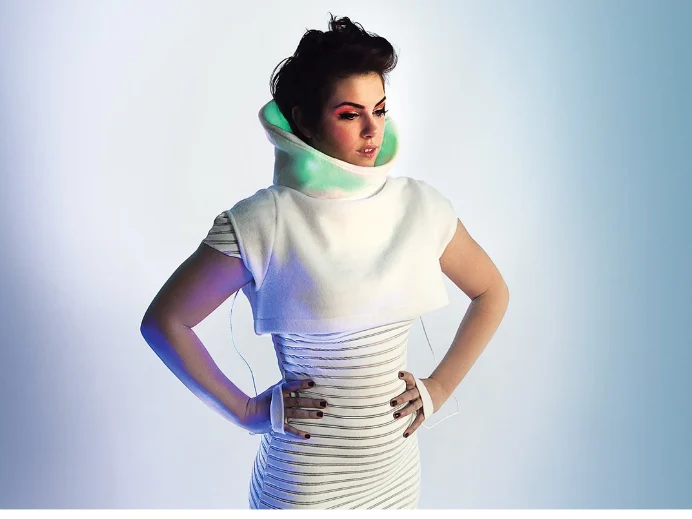- Emotional clothing is a type of wearable technology that uses biofeedback to respond to the wearer’s physiological and emotional states.
- In essence, emotional clothing is a sensory prosthesis that can both receive and send signals about the wearer’s state of mind and body.
- Iga Węglińska has developed a collection called “Emotional Clothing – Sensory Prosthesis Garment” that uses these responsive materials to signal the psycho-physiological changes in the user’s body.
Emotional clothing is a pioneering concept within the fashion industry that integrates technology with textiles, resulting in garments capable of reflecting and responding to the wearer’s emotional state. This innovative approach utilises smart textiles and biofeedback mechanisms to create a new form of non-verbal communication and self-awareness.
What is emotional clothing
Emotional clothing is an innovative concept that integrates technology with the expression of human emotions. It’s a type of wearable technology that uses biofeedback to respond to the wearer’s physiological and emotional states.
The concept is to create garments that act as an extension of the wearer’s mind and body, enhancing the user’s “sense of taking part” in their immediate environment. These smart materials can react to body temperature, galvanic skin response, heart rate, and even proprioception.
In essence, emotional clothing is a sensory prosthesis that can both receive and send signals about the wearer’s state of mind and body. This technology is still in its early stages, but it has the potential to transform how we perceive and interact with our clothing, making it an extension of our emotional selves.
Also read: Smart wearables: Can data tracking really boost health?
Technology integration
The latest developments in emotional clothing involve the use of smart materials that respond to various physiological indicators such as body temperature, galvanic skin response, heart rate, and proprioception.
The latest sensors and smart materials in emotional clothing include the following main categories:
- Flexible sensors: these sensors are used in a wide range of applications in sports, healthcare, recreation and special environments. For example, researchers such as Wang used sensing technology to integrate miniature sensors and light-emitting diodes (LEDs) into a couple’s clothing prototype, and evaluated the smart clothing they produced against other types of smart clothing to make a preliminary emotional evaluation.
- Biosensor: this sensor is implanted into the garment to function close to the human skin and is used in wearable health-detecting smart garments. It applies advanced technologies such as human-computer interaction and smart sensing.
- Smart colour-changing materials: These materials enable the colour of clothing to change to express emotions or monitor health conditions. For example, a study has designed a smart colour-changing garment that monitors endurance and athletes’ skin temperature.
Design to me is a tool for asking questions and reflecting on the world around us.
Iga Węglińska, Polish designer and researcher
- Phase-change materials and stimulus-responsive hydrogels: these materials are able to change their physical properties, such as temperature, colour or shape, in response to changes in the external environment or internal physiological signals.
- Fibre-optic fabrics and nanomaterials: these novel materials are being developed to improve the functionality and comfort of smart clothing.
- Interactive textiles: These textiles can sense stimuli or signals from the user and the environment and respond and adapt accordingly. They combine the advantages of traditional textiles with the ability to integrate technologies that are ideally suited to support users’ short- and long-term emotional self-regulation needs.
- VIBE necklace: An emotion sensor developed by Philips that combines conductive ink and textile sensors to read a wide range of biosignals from the wearer and the person they are communicating with.
- Smart Pacer jumpsuit: a built-in sensor that monitors changes in body dynamics and translates the data obtained into a musical melody as a new and fun experience.
Iga Węglińska’s emotional clothing
Iga Węglińska, a visionary designer from Poland, has crafted a groundbreaking collection known as emotional clothing that is as innovative as it is intimate. This collection, which was a part of her doctoral dissertation at the Academy of Fine Arts in Krakow, is designed to “broaden the experience of clothing” by creating a responsive and interactive relationship between the wearer and the attire.
At the heart of emotional clothing is the use of polysensory silhouettes that employ biofeedback and sensory substitution. These smart garments are crafted from materials that react dynamically to changes in the wearer’s body, such as temperature, heart rate, and galvanic skin response (GSR).

For instance, one top in the collection changes from black to translucent based on body temperature and heart rate, while another features pink LED lights that respond to stress levels by sensing sweat levels on the skin.
The integration of technology in these garments is not just for aesthetic purposes; it is deeply rooted in the concept of biofeedback, a therapeutic technique that helps individuals understand their bodies better through sensor-based feedback.
Węglińska’s work is inspired by the theory of extended mind, which posits that material objects can become part of our cognitive processes, acting as external elements in our perception.
The emotional clothing collection is more than just a fashion statement; it is a testament to the potential of wearable technology to enhance our emotional well-being. It acts as a bridge between advanced technology and human touch, providing a new dimension in how we perceive and interact with our clothing.

In terms of materials, Węglińska has experimented with a variety of smart textiles, including neoprene, thermoplastic polyester, polyurethane leather, and polylactic plastic, to create tops that mimic the behavior of human skin.
The use of a conductive thread allows electrical current to flow, enabling light to travel through the material, symbolizing the intimate relationship between the wearer and the garment.
The potential applications of emotional clothing are vast, from aiding individuals in managing stress to providing a new form of non-verbal communication. It is a pioneering step towards a future where our attire is not just an expression of style but also a reflection of our emotional state, offering a deeper level of connection and understanding.
Daan Roosegaarde’s “Intimacy 2.0”
Daan Roosegaarde‘s “Intimacy 2.0” is a pioneering concept in the realm of interactive fashion. This high-tech garment is designed to literally reflect the wearer’s emotional state by changing its transparency based on the individual’s physiological responses, such as heart rate or body heat.
The fabric used in “Intimacy 2.0” integrates smart e-foils, a material akin to electronic paper, which reacts to the wearer’s vital signs and adjusts its opacity accordingly.
In the Intimacy 2.0 project, the wearer controls changes in the transparency of the clothing through its biofeedback. Specifically, as the wearer’s heart rate accelerates, the clothing gradually becomes transparent.
This process is made possible by sensors hidden in the garment that detect the wearer’s body temperature and heart rate. As a result, the wearer’s physiological response directly affects the transparency of the clothing, thus creating a sensual game of disclosure in social interactions.

The project was a collaboration between Studio Roosegaarde and V2_Lab, and it builds upon the initial “Intimacy 1.0” concept. The 2.0 version enhances the technology, making it more sensitive and responsive to the wearer’s emotional changes.
The design is not just about aesthetics; it’s a statement on the relationship between humans and technology, and how close proximity and interaction can unveil the hidden layers of intimacy.
“Intimacy 2.0” has been exhibited globally, sparking conversations about the future of wearable technology and its potential applications in various fields, from fashion to healthcare. The dress comes in black and white options, and the studio suggests it as a perfect choice for red carpet events, indicating the blend of technology and glamour.
The design of “Intimacy 2.0” is a testament to Daan Roosegaarde’s innovative approach to art and fashion, showcasing how technology can be seamlessly integrated into everyday life to create garments that are as responsive as they are stylish.
Pop quiz
How does the ‘Intimacy 2.0’ garment by Daan Roosegaarde respond to the wearer’s physiological changes?
A. It becomes more opaque
B. It changes colour
C. It alters its transparency
D. It plays music
The answer is at the bottom of this article.
The GER mood sweater by SENSOREE
The GER mood sweater by SENSOREE is an innovative wearable that translates the wearer’s emotions into light. This interactive garment utilises technology to bridge the gap between our internal feelings and external expressions. The sweater is embedded with soft sensors that respond to physiological changes, such as the electrical conductivity of the skin, which is an indicator of emotional arousal.
The Galvanic Extimacy Responder (GER) sensors located on the hands pick up on the wearer’s excitement levels and convert this data into a spectrum of affective colours. The high collar of the sweater, which is equipped with LED lights, illuminates to reflect the wearer’s emotional state. This visual feedback serves as an immediate representation of one’s feelings, effectively turning the collar into a tele-display or an “external blush”.

Each colour corresponds to a specific emotion: blue signifies calm, pink indicates excitement, yellow expresses ecstasy, and red suggests nervousness or being in love. The idea behind the GER Mood Sweater is to foster a new form of communication that is both intuitive and expressive, allowing individuals to share their emotional state in a novel and non-verbal manner.
SENSOREE, the company behind this concept, is dedicated to advancing the field of wearable technology and interactive installations. They aim to explore the intersection of technology and intimacy, using sustainable materials and sensitive monitoring technologies to create garments that are as responsive as they are fashionable.
The GER Mood Sweater is not just a piece of clothing; it’s a statement on the potential of wearable technology to transform how we interact and empathise with one another in a digital age. With only a limited edition of 100 pieces planned, this sweater is a testament to the fusion of art, technology, and human emotion.
Importance of the emotional clothing
Emotional clothing is a pioneering concept within the digital society that addresses the phenomenon of emotional fatigue. As we navigate an increasingly virtual world, the boundaries between our online and offline lives blur, often leading to heightened stress and a sense of emotional exhaustion.
Emotional clothing aims to counteract this by providing a tangible and responsive interface between the individual and their environment, enhancing self-awareness and offering a form of biofeedback that can promote emotional well-being.
With Emotional Clothing, I wanted to create a narrative where technology understands and responds to human behavior.
Iga Węglińska, Polish designer and researcher
The role of emotional clothing in mitigating emotional fatigue is multifaceted.
- Visual feedback: Firstly, it serves as a direct reflection of one’s emotional state, offering immediate visual feedback that can help individuals recognise and address their feelings more effectively. By integrating smart textiles and sensors, these garments can respond to physiological indicators such as heart rate and body temperature, which are often correlated with emotional arousal.
- Deeper connection: Emotional clothing can foster a deeper connection with oneself and others. In a digital society where face-to-face interactions are sometimes reduced, the ability to visually communicate emotions can foster empathy and understanding, thus combating the sense of isolation that can accompany emotional fatigue.
- Therapeutic applications: The significance of emotional clothing also lies in its potential therapeutic applications. For instance, garments that respond to the wearer’s stress levels can be utilised in therapeutic settings to help patients manage anxiety or recover from trauma. By providing a physical manifestation of emotional states, these garments can serve as a tool for self-regulation and stress management.
- Cultural expression and identity: Emotional clothing also plays a role in cultural expression and identity. It can serve as a medium for expressing cultural and social identity, with the potential to convey emotional well-being. This innovation could help people better understand their own feelings and those of others, offering a deeper sense of personal expressionism and a new dimension of identity expression.
Emotional clothing represents an intersection of fashion, technology, and psychology, offering a new form of wearable art that is as functional as it is aesthetically pleasing. It challenges the traditional notions of clothing as mere adornment, transforming attire into an active participant in the wearer’s emotional landscape.
Emotional clothing is a response to the emotional challenges posed by the digital society. It stands as a testament to the potential of technology to enrich our emotional lives, providing a medium for self-expression and a tool for emotional regulation in a world where emotional fatigue is a growing concern.
Also read: Technology and the Olympics: The leap from Tokyo to Paris
Considerations
However, emotional clothing relies on collecting and analysing physiological data of the wearer, such as heart rate and body temperature. The collection and storage of such sensitive information may raise the risk of privacy breaches, especially when data protection regulations are inadequate. In addition, if this data is used inappropriately or falls into the wrong hands, it may pose a security threat to the wearer.
Beauty is not about aesthetics alone; it’s about having a positive impact on society.
Daan Roosegarde, Dutch artist and innovator, founder of Studio Roosegaarde.
The design and application of technology may inadvertently infringe on the autonomy of the individual, as garments are able to respond to and influence the emotional state of the wearer. This may raise concerns about the manipulation of personal emotions, especially in applications such as advertising and marketing.
In addition, an over-reliance on technology to understand and express emotions may diminish people’s natural ability to express and communicate their emotions, leading to alienation of interpersonal relationships.
Most importantly, people should have their own private space, their own space bubble, and this kind of emotional apparel exposes personal emotions completely.
Future of emotional clothing
Emotional clothing is expected to integrate further advancements in technology, such as the internet of things (IoT), artificial intelligence, and machine learning. These integrations could enable real-time emotional data feedback and more nuanced responses from garments, potentially creating a new standard in the apparel industry where emotional intelligence is as important as aesthetic design.
In conclusion, emotional clothing is an emerging trend that combines technology with fashion to create garments that are more than just clothing—they are extensions of our emotional selves. As the field continues to develop, we can anticipate a future where our attire not only expresses our identity but also communicates our emotional state, enriching our interactions and understanding of one another.
The correct answer to the pop quiz is C. It alters its transparency.
